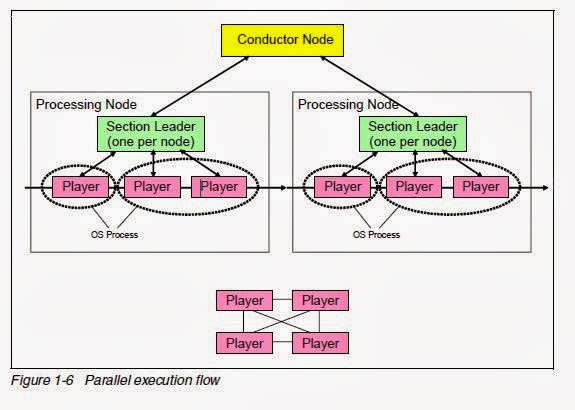This Blog gives you the generation of the OSH (Orchestrate® Shell Script) script, and
The execution flow of IBM InfoSphere DataStage using the Information
Server engine.
and Information about Conductor Node, Section Leader and Player in datastage job.
OSH script :
The IBM InfoSphere DataStage and
QualityStage Designer client creates IBM InfoSphere DataStage jobs that are
compiled into parallel job flows, and reusable components that execute on the
parallel Information Server engine. It allows you to use familiar graphical
point-and-click techniques to develop job flows for extracting, cleansing,
transforming, integrating, and loading data into target files,
target systems, or packaged applications.
The Designer generates all the code.
It generates the OSH (Orchestrate Shell Script) and C++ code for
any Transformer stages used.
Briefly, the Designer performs the
following tasks:
1.Validates
link requirements, mandatory stage options, transformer logic, etc.
2.Generates OSH representation of data flows and stages
(representations of framework “operators”).
3.Generates transform code for each Transformer stage which is
then compiled into C++ and then to corresponding native operators.
4.Reusable
BuildOp stages can be compiled using the Designer GUI or from the command line.
Here is a brief primer on the OSH:
1.
Comment blocks introduce each operator, the order of which is determined by the
order stages were added to the canvas.
2.OSH uses the familiar syntax of the UNIX shell. such as Operator
name, schema, operator options (“-name value” format), input (indicated by
n< where n is the input#), and output (indicated by the n> where n is the
output #).
3. For every operator, input and/or output data sets are numbered
sequentially starting from zero.
4.
Virtual data sets (in memory native representation of data links) are generated
to connect operators.
Note: The actual
execution order of operators is dictated by input/output designators, and not
by their placement on the diagram. The data sets connect the OSH operators.
These are “virtual data sets”, that is, in memory data flows. Link names are
used in data set names — it is therefore good practice to give the links
meaningful names.
Framework (Information Server Engine)
terms and DataStage terms have equivalency. The GUI frequently uses terms from
both paradigms. Runtime messages use framework terminology because the
framework engine is where execution occurs. The following list shows the
equivalency between framework and
DataStage terms:
1.
Schema corresponds to table definition
2.
Property corresponds to format
3. Type corresponds to SQL type and
length
4.
Virtual data set corresponds to link
5. Record/field corresponds to row/column
6. Operator corresponds to stage
7. Step, flow, OSH command correspond to a job
8. Framework corresponds to Information Server
Engine
Execution
flow
When you execute a job, the generated
OSH and contents of the configuration file ($APT_CONFIG_FILE) is used to
compose a “score”. This is similar to a SQL query optimization plan. At
runtime, IBM InfoSphere DataStage identifies the degree of parallelism and node
assignments for each operator, and inserts sorts and partitioners as needed to
ensure correct results. It also defines the connection topology (virtual data
sets/links) between adjacent operators/stages, and inserts buffer operators to
prevent deadlocks (for example, in fork-joins). It also defines the number of actual
OS processes. Multiple operators/stages are combined within a single OS process
as appropriate, to improve performance and optimize resource requirements.
The job score is used to fork
processes with communication interconnects for data, message and control3.
Processing begins after the job score and processes are created. Job processing
ends when either the last row of data is processed by the final operator, a
fatal error is encountered by any operator, or the job is halted by DataStage
Job Control or human intervention such as DataStage Director STOP.
Job scores are divided into two
sections — data sets (partitioning and collecting) and operators (node/operator
mapping). Both sections identify sequential or parallel processing. The
execution (orchestra) manages control and message flow across processes and
consists of the conductor node and one or more processing nodes as shown in
Figure 1-6. Actual data flows from player to player — the conductor and section
leader are only used to control process execution through control and
message channels.
Conductor
is
the initial framework process. It creates the Section Leader (SL) processes
(one per node), consolidates messages to the DataStage log, and manages orderly
shutdown. The Conductor node has the start-up process. The Conductor also
communicates with the players.
Note:
1. Set
$APT_STARTUP_STATUS to show each step of the job startup, and $APT_PM_SHOW_PIDS
to show process IDs in the DataStage
log.
2. You can direct the score to a job log
by setting $APT_DUMP_SCORE.To identify the Score dump, look for “main program:
This step....”.
Section
Leader is a process that forks player processes (one per stage) and manages
up/down communications. SLs communicate between the conductor and player
processes only. For a given parallel configuration file,one section leader will
be started for each logical node.
Players are the
actual processes associated with the stages. It sends stderr and stdout to the
SL, establishes connections to other players for data flow, and cleans up on
completion. Each player has to be able to communicate with every other player.
There are separate communication channels
(pathways) for control, errors,
messages and data. The data channel does not go through the section
leader/conductor as this would limit scalability. Data flows directly from
upstream operator to downstream operator.


No comments:
Post a Comment